Dolphins
Why are these structures called dolphins?
The etymology is a tad unclear. It seems that early mariners applied the term to all manner of structures fancifully linked to the animal. Somewhere along the line it was applied to a group of piles driven close together and bound into a single structure. And that is how it is defined in maritime glossaries to this day.
Usage on Kootenay Lake is even more specialized: it is only applied to a group of bound piles used to mark the navigable channel. What is clear is that this is a very old term which has survived in only a few places. Although it is official, when I have used it locally, it is rarely recognized. Upon an explanation, the person will often say: “Oh, you mean the buoys!” No, they aren’t the least bit buoyant; I mean the dolphins.
For me, there is nothing which so symbolizes our interaction with Kootenay Lake as the dolphins. These strangely named channel markers are found along the whole Lake, but particularly along the West Arm.
For over a century (probably since the first sternwheelers) there have been dolphins on the Lake. Initially they were wooden pilings topped by a platform and a triangle of parallel white boards pointing to the channel.
Originally there were six dolphins on the West Arm: at Harrop, Twelve-Mile Point, Nine-Mile Point, Seven-Mile Point, Five-Mile Point, and Roberts Point (huh? there isn't one there now, did the story mean Two-mile Point). At some point, lights were added (possibly kerosene), but in 1932 the lights were removed. The sternwheelers did have powerful search lights and maybe this was deemed sufficient for finding the dolphins at night. Certainly, by the late 1940s, battery-powered electric lights were in place. In 1938, the Government approved a petitioned from residents for the installation of more dolphins: one opposite the dolphin at Two-mile point, and two at Kokanee Creek. (information from the Nelson Daily News, Nov. 26, 1938). I must admit that I would have expected a dolphin at Balfour to have been mentioned.
In the early 1970s the number of Ospreys around the Lake began to increase, and many of these magnificent birds chose the dolphins as a nesting site. Now, an Osprey nest is a rather substantial structure, and when built at the top of a dolphin, it engulfed the light rendering it useless. Rather than removing the nests, the government accepted a suggestion by Bob Denison, whose summer cottage at Atbara was adjacent to the Nine-Mile dolphin, that platforms be added above the light. These platforms now characterize all dolphins and most play host to Osprey nests and Ospreys.
In the 1980s the markings began to conform to international standards and sprouted red triangles and green squares, and unfortunately lost the more intuitive boards pointing to the channel.
Finally, with the dawn of the twenty-first century, steel replaced the wood of the pilings. The details change, but the dolphins abide on Kootenay Lake, first serving the sternwheelers, now the private pleasure craft (which occasionally run into them).
Fisheries and Oceans Canada offers a list of the Dolphins of Kootenay Lake.
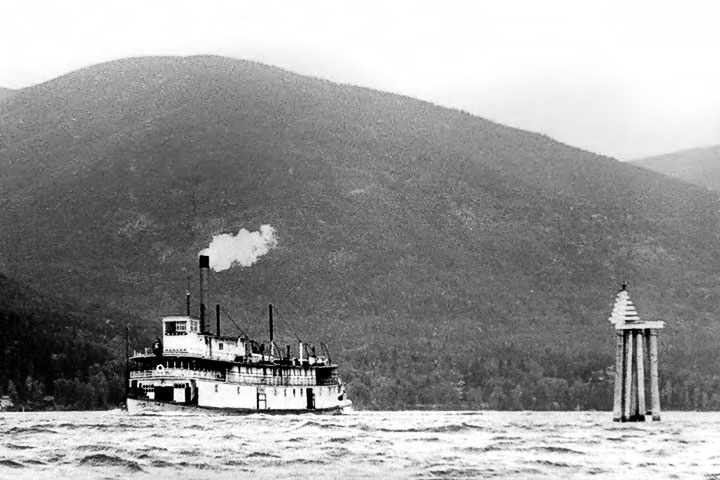 Five-mile point dolphin, 1952 Dolphins had served sternwheelers since the 1890s. When the Moyie (seen here) went out of service in 1957, that link ended. Note, pilings are unpainted, but the white boards atop point to the channel.
Five-mile point dolphin, 1952 Dolphins had served sternwheelers since the 1890s. When the Moyie (seen here) went out of service in 1957, that link ended. Note, pilings are unpainted, but the white boards atop point to the channel.
The picture was taken by my cousin, Denis Daly; he and I had rowed out to meet the Moyie as it went down the Lake to Nelson.
 Five-mile point dolphin, 1970 The dawn of yet another idyllic August day. The dolphin, fisherman, and point are sunlit; the mountain remains in shadow.
Five-mile point dolphin, 1970 The dawn of yet another idyllic August day. The dolphin, fisherman, and point are sunlit; the mountain remains in shadow.
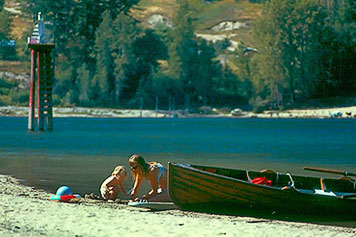 Five-mile point dolphin, 1970 In this view from the point itself, it is clear that the dolphin is much the same as it had been for a long time. It has yet to gain a platform for the osprey. There is no solar panel; the box for batteries is on the left side of the platform. I wonder if painting the pilings red really did increase visibility. Note the wooden rowboat.
Five-mile point dolphin, 1970 In this view from the point itself, it is clear that the dolphin is much the same as it had been for a long time. It has yet to gain a platform for the osprey. There is no solar panel; the box for batteries is on the left side of the platform. I wonder if painting the pilings red really did increase visibility. Note the wooden rowboat.
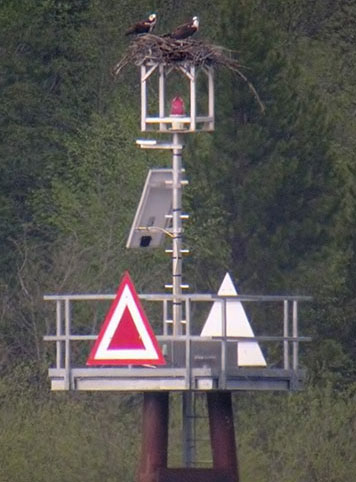 The Nine-mile dolphin (2005) hosts a breeding pair of Ospreys. The dolphin on this spot is significant. It was the first one on the Lake (and probably BC) to provide a platform for Ospreys.
The Nine-mile dolphin (2005) hosts a breeding pair of Ospreys. The dolphin on this spot is significant. It was the first one on the Lake (and probably BC) to provide a platform for Ospreys.
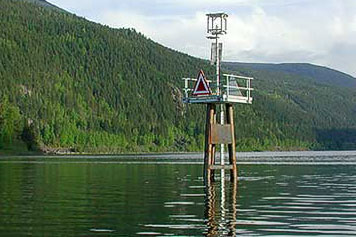 Five-mile point dolphin, 2002 The modern, well equipped Kootenay Lake dolphin: steel pilings, a platform, a triangle or square, a solar panel, a light, and, of course, a platform for an Osprey nest. This dolphin bears a triangle; pass on the north side of it.
Five-mile point dolphin, 2002 The modern, well equipped Kootenay Lake dolphin: steel pilings, a platform, a triangle or square, a solar panel, a light, and, of course, a platform for an Osprey nest. This dolphin bears a triangle; pass on the north side of it.
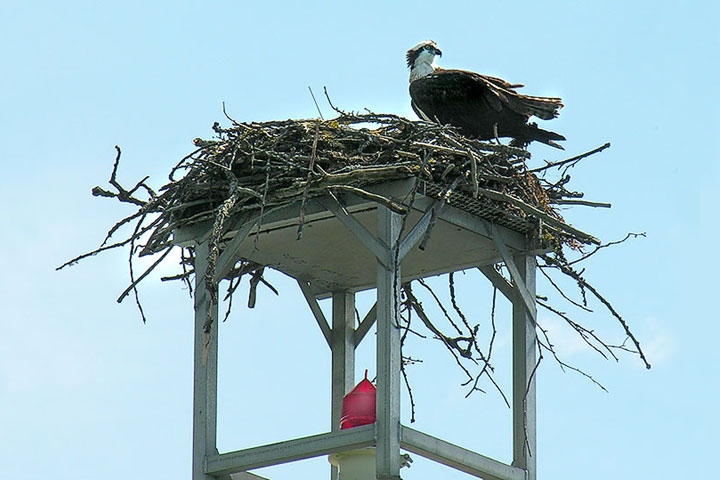 Osprey on the Nine-mile dolphin No modern, well-equipped, dolphin is complete without its resident Osprey in the spring and summer. From a look at the nest, it is easy to see it would render the light useless in the absence of a platform.
Osprey on the Nine-mile dolphin No modern, well-equipped, dolphin is complete without its resident Osprey in the spring and summer. From a look at the nest, it is easy to see it would render the light useless in the absence of a platform.
 Fraser Narrows looking west The Fraser Narrows is the narrowest of all the constrictions on the Lake. The dolphin bears a triangle: pass it on the north side.
Fraser Narrows looking west The Fraser Narrows is the narrowest of all the constrictions on the Lake. The dolphin bears a triangle: pass it on the north side.
 Harrop narrows looking west The Harrop Narrows has a cable ferry (centre left). The dolphin on the point bears a square: pass it on the south side.
Harrop narrows looking west The Harrop Narrows has a cable ferry (centre left). The dolphin on the point bears a square: pass it on the south side.
![]()